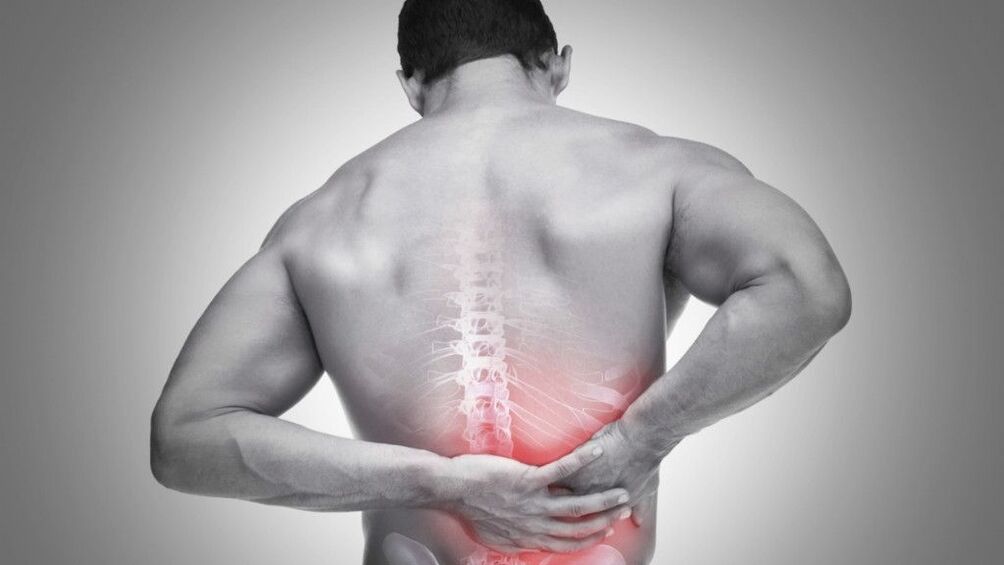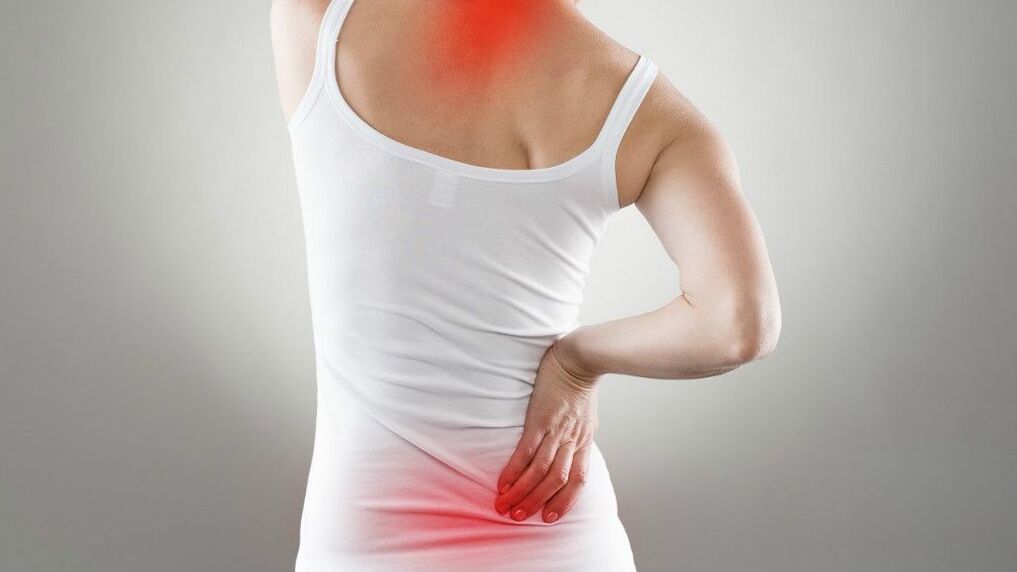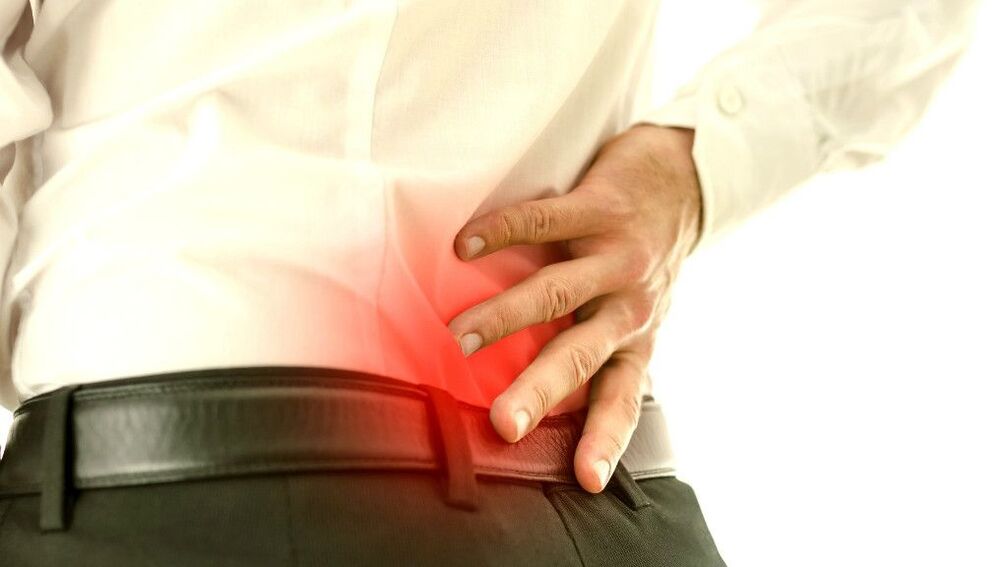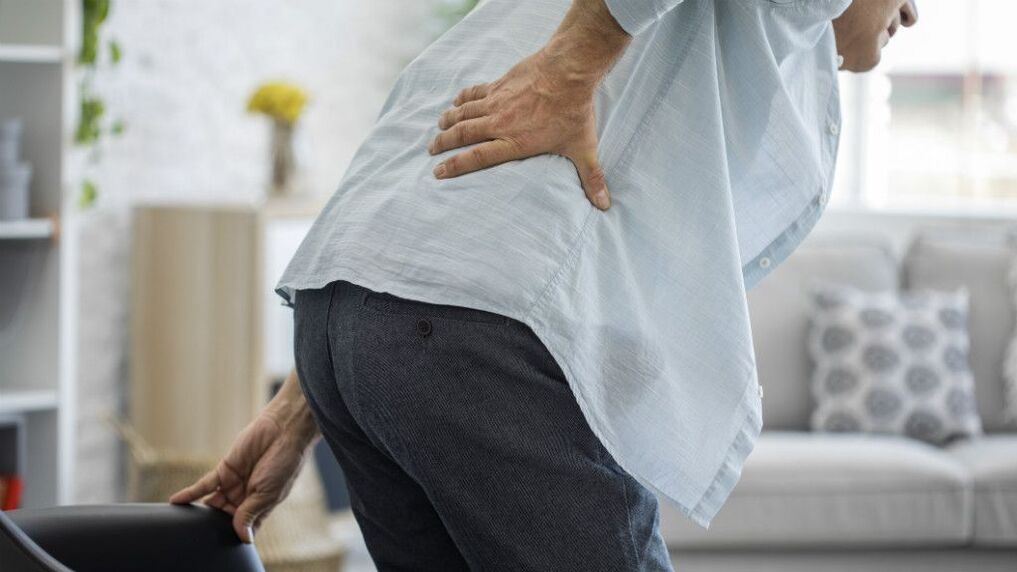Pain, lumbago, constant difficulty, do you know such feelings in your back?
Harmless pulling pain is often a sign of a dangerous disease. In this article, we analyze all the causes of the disease.

Cause
1. Diseases of the spine and pelvic bones.
- Osteochondrosis (damage to the intervertebral discs (protrusion, disc herniation));
- Spondylitis (an inflammatory disease of the spine);
- Spondyloarthrosis (arthrosis of the intervertebral joints);
- Spondylosis (bone growth);
- Spondyloarthritis (inflammation of the intervertebral joints);
- Myositis (inflammation of the muscles);
- Osteoprosis (decreased bone density) with compression fractures of vertebrae and other bone structures;
- Injury to the spine and pelvic bones (fractures, cracks);
- Sacroiliitis (inflammation of the sacroiliac joints);
- Tumors of bone structures and soft tissues.
2. Reflective pain in the lumbar spine,associated with diseases of the abdominal and pelvic organs (inflammatory diseases and tumors), this pain is often accompanied by abdominal pain.
The nature of the painmay be different:
- Acute pain occurs rapidly, suddenly;
- Chronic - pain lasting more than 2 months, occurs as spinal diseases progress;
- The urogenital system, with inflammatory pathologies of the abdominal organs (chronic gastritis, pancreatitis, gallbladder inflammation, enterocolitis).
The intensity of the pain
From discomfort to severe pain.
In the case of acute and intense abdominal pain radiating to the lumbar spine, surgical pathology requiring urgent surgical intervention (gastrointestinal bleeding, appendicitis, peritonitis, etc. ) should always be ruled out.
Severe pain in the lumbar spine
This can be a reflex (muscle cramps caused by irritation of receptors in the paravertebral muscles). A person is hurt by coughing, sneezing, every movement is accompanied by pain. When the nerve root is compressed (disc protrusion, disc herniation), the pain spreads to the lower extremities, often from one side.
Myofascial syndrome
This is due to irritation of the pain receptors in the muscles and fascia. Triggers (pain nodules) are formed in the muscles, the pain syndrome is chronic, often recurrent.
Any damage to the soft tissues or bone structures is accompanied by intense pain.
When to see a doctor: If you have any pain in your lumbar spine, you should see a doctor to help diagnose the cause of the pain and take action.
Pain in men, women
With diseases of the reproductive system, pain syndrome is different in men and women.
Men with prostate pathology are characterized by pulling, aching pain, often associated with urinary incontinence. In women, the symptom is often acute, pronounced. In case of ovarian apoplexy or ectopic pregnancy, the pain is unbearable. Usually, the syndrome is more intense on the affected side.
Endometriosis, uterine myoma - aching feelings, pulling. If the pain is related to spinal pathology, the intensity of the pain is independent of gender. It is noticeable that the men go to the doctor later.
Diagnostics
Examination by professionals
- vertebroneurologist;
- gastroenterologist;
- neurosurgeon;
- surgeon;
- gynecologist;
- urologist;
- rheumatologist;
- oncologist.
Laboratory methods
- general blood test (exclusion of the inflammatory process, leukocyte level, ESR), exclusion of anemia (hemoglobin level);
- general urine test: exclusion of the inflammatory process in the bladder, kidneys (bacteria, leukocytes, erythrocytes);
- analysis of feces for occult blood;
- blood biochemistry: rheumatological tests to rule out systemic inflammation (CRP, RF, uric acid), assessment of liver function (alt ast bilirubin), assessment of renal function (creatinine urea), pancreatic function (amylase), etc.
Instrumental research methods
- radiography of the lumbar spine and pelvic bones; smooth X-ray of the abdominal cavity (except for intestinal obstruction);
- Ultrasound of the abdominal and pelvic organs;
- FGDS;
- colonoscopy;
- Lumbar spine MRI (CT), lumbar MRI (CT) contrast;
- Contrast of abdominal and pelvic MRI (CT), abdominal and pelvic MRI (CT).
Treatment
When a tumor is detected, treatment, surgery, or other tactics (observation and treatment in a neurosurgical, surgical hospital, oncology outpatient clinic) are determined depending on the location and nature of the tumor.
Drug treatment
Diseases of the spine (more often in osteochondrosis):
- NSAIDs;
- muscle relaxants;
- opioid analgesics;
- diuretics;
- vascular drugs;
- antibacterial drugs;
- medical and medical blockade with novocaine, lidocaine and diprospan.
Non-pharmacological methods
It is mainly used to treat spinal diseases:
- physiotherapy (magnetic laser, magnetotherapy, CMT with novocaine, etc. );
- acupuncture;
- hardware traction of the lumbar spine;
- hand therapy;
- massage;
- balneotherapy (mud applications, ozokerite);
- Practical therapy.


Prevention of spinal diseases (in the context of osteochondrosis) is all of the above methods (except physiotherapy).
Prevention of diseases of the gastrointestinal tract: diet, diet, work and rest.
If you have lumbar pain, go to the clinic.
The hospital has all the professionals and all the diagnostic methods presented in this article. There are also inpatient departments: a gastroenterology department and an urban vertebrology center. All treatment methods are used except surgery. You can be observed, examined and treated on an outpatient basis, i. e. outside the hospital.














































